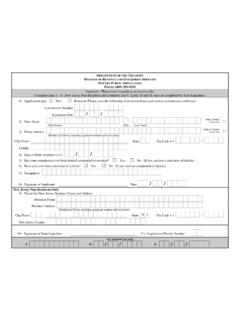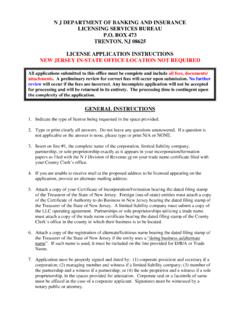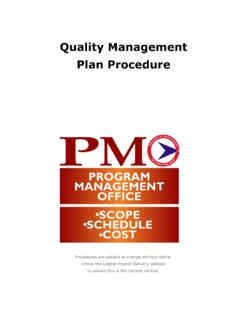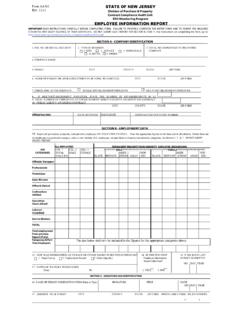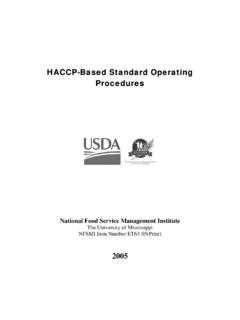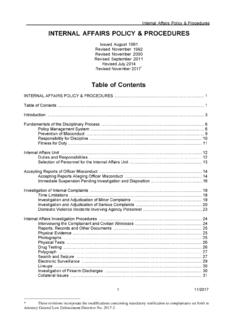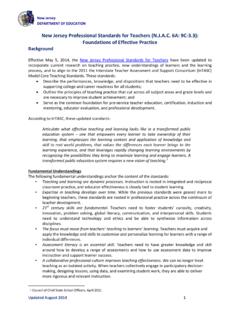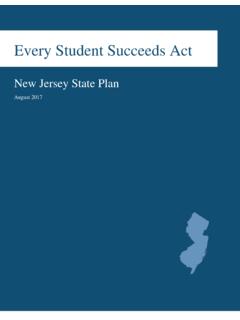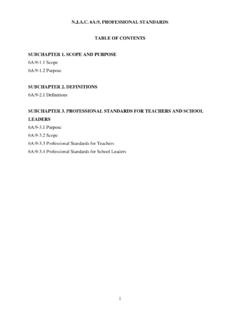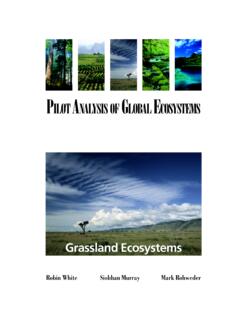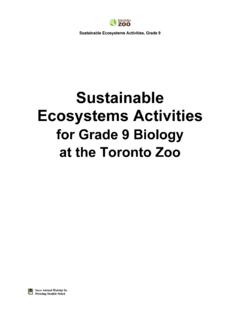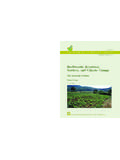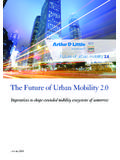Transcription of The Value of New Jersey’s Ecosystem Services and …
1 The Value of New Jersey s Ecosystem Servicesand Natural CapitalRobert CostanzaMatthew WilsonAustin TroyAlexey VoinovShuang LiuJohn D AgostinoGund Institute for Ecological EconomicsRubenstein School of Environment and Natural ResourcesUniversity of VermontBurlington, VT05405 Project supported by:Contract # SR04-075 William J. Mates, Project OfficerNew Jersey Department of Environmental ProtectionDivision of Science, Research, and TechnologyPO Box 409, Trenton, NJ 08625-0409 July 2006iiExecutive SummaryThis report summarizes the results of a two-year study of the economic Value of New Jersey snatural capital. Natural capital consists of those components of the natural environment that provide aalong-term stream of benefits to individual people and to society as a whole; the Value of natural capital isdefined in this report as the present Value of that benefit stream. Many of the benefits provided by naturalcapital come from ecological systems ( ecosystems ); an Ecosystem is a dynamic complex of plant,animal, and microorganism communities and their nonliving environment, all interacting as a benefits provided by natural capital include both goods and Services ; goods come from bothecosystems ( , timber) and abiotic (non-living) sources ( , mineral deposits), while Services are aremainly provided by ecosystems.
2 Examples of Ecosystem Services ( ecoservices ) include temporarystorage of flood waters by wetlands, long-term storage of climate-altering greenhouse gases in forests,dilution and assimilation of wastes by rivers, and numerousothers. All of these Services provideeconomic Value to human beings. The goods provided by New Jersey s natural capital are covered in aseparate study; this report focuses on the Services provided the state s ecosystems, covering twelvedifferenttypes of Ecosystem and twelve different policy, planning, and regulatory decisions, it is important for New Jerseyans to know not onlywhat Ecosystem goods and Services will beaffected bypublic and private actions, but also what theireconomic Value is relative to other marketed and non-marketedgoods and Services , such as thoseprovided by physical capital ( , roads), human capital investment ( , education), etc. As a way ofexpressing these relative values or trade-offs , this study estimated the dollar Value of the ecoservicesproduced by New Jersey s ecosystems.
3 In deriving these estimates, we used three different approaches: Value transfer, hedonic analysis, and spatial Value TransferValue transfer identifies previously conducted high-quality studies of the Value of ecoservices ina variety of locations using a variety of valuation methods and applies them to New Jersey transfer is the preferred valuation technique where (as in this case) performing original research foran extended geographic region with varied Ecosystem types would be prohibitively the present study, we identified and used a total of 100earlier studies covering the types ofecosystems present in New Jersey; 94 of these studies are original research previously published in peer-reviewed journals. Some studies provided more than one estimated ecoservice Value for a givenecosystem; the set of 100 studies provided a total of 210 individual Value estimates. We translated eachestimate into dollars per acre per year, computed the average Value for a given ecoservice for a givenecosystem, and multiplied the average by the total statewide acreage for that results are summarized below; all figures are 2004 dollars.
4 The figures include onlyecosystem Services ; they do not include Ecosystem or abiotic goods or secondary economic activityrelated to a given Wetlandsprovided the largest dollar Value of Ecosystem Services : $ billion/yr for freshwaterwetlands and $ billion/yr for saltwater wetlands. The most valuable Services weredisturbance regulation ($ billion/yr), water filtration ($ billion/yr), and water supply ($ ) forfreshwater wetlands, and waste treatment ($ ) for saltwater wetlands.(Disturbance regulation means the buffering of floods, storm surges, and other events thatthreatenthings valued by individuals or by society as a whole.)2. Marine ecosystemsprovided the second-largest dollar amount of Ecosystem Services : $ for estuaries and tidal bays and about $389 million/yr for other coastal waters,including the coastal shelf out to the three-mile limit. (It should be noted that the fish andshellfish obtained from these ecosystems are covered elsewhere in this report and are notincluded in these totals.)
5 Nutrient cycling ( , waste dilution andremoval) was the mostimportant service provided by marine ecosystems, with a Value of $ Forestscover the largest area of any ecosystemtype in New Jersey, and because of that thetotalvalue of the Ecosystem Services they provide is one of the highest at $ billion/yr, excludingthe Value of timber. Habitat Services are currently the most important of these Services ($ ); other important Services provided by forests include water supply and pollination(about $238 million/yreach) and aesthetic and recreational amenities ($179 million/yr).4. Urban green spacecovers relatively little of New Jersey but has a relatively high dollar valueper acre and provides an estimated $419 million of Ecosystem Services annually, principallyaesthetic and recreational amenities ($361 million/yr). Ecoservice values for other types ofurban land and for barren land were not investigated in this Beaches(including dunes) provided by far the highest ecoservice Value per acre; their smallarea limited their annual ecoservice Value to about$330 million, mainly disturbance regulation($214 million/yr) and aesthetic and recreational amenities ($116 million/yr).
6 6. Agricultural landincludes both cropland (estimated at $78 million/yr of Ecosystem Services ) andpastureland (estimated at $45 million/yr). These values relate solely to the Services provided byfarmland, mainly habitat Services from cropland ($75 million/yr) and waste treatment servicesfrom pasture land ($26 million/yr). They do not include the Value of the food provided byfarms, which is covered Open fresh water and riparian buffersprovided Services with an estimated annual Value of $66million and $51 million respectively, mainly water supply ($64 million/yr) and aesthetic andrecreational amenities ($51 million/yr). Another part of this report covers the Value of water asan Ecosystem total Value of these Ecosystem Services is $ billion/year. If we exclude studies whichwere not peer-reviewed and/or which did not report on original research, the result is a lower estimate of$ billion/year.
7 However,this exclusion makes it impossible to estimate values for a number ofecosystems and/or ecoservices, and we believe that the higher figure better represents the Value of theservices provided by New Jersey s ecosystems. If the excluded studies are added back but weighted at50%, the total Value of Ecosystem Services would be $ flows of ecoservices can be discounted (converted to their present Value equivalents) in anumber of ways; the subject of discounting is controversial and is the subject of active research, with newdiscounting techniques being proposed regularly. If we use conventional discounting with a constantannual discount rate of 3% (a rate often used in studies of this type), and if we assume that the $ of ecoservices continues in perpetuity, the present Value of those Services , , the Value of thenatural capital which provides the Services , would be $648 billion. Using the same assumptions, thepresent values of the $ billion/yr and $ billion/yr flows of Services (see above) would be $387billion and $517 billion decisions on environmental policy and land use are made at the local level, and it istherefore important to translate the statewide results described above into local values.
8 Based on theresults of the Value transfer analysis, we mapped the aggregate Value of Ecosystem Services by county, bywatershed, and by sub-watershed. The maps show substantial differences in ecoservice values based onthe predominant types of land cover in different parts of the state. In general, areas containing wetlands,ivestuaries, tidal bays, and beaches had thehighest Ecosystem service values per acre. Our maps are basedon 1995/1997 land use/land cover (LULC) data, which was the most current data available at the time ofour study; consideration should be given to updating both the Value estimates and the maps when morerecent LULC data become a number of reasons, the dollar amounts presented above are almostcertainly conservative, , they underestimate the true Value of New Jersey s Ecosystem Services . Thesereasons include gaps inthe valuation literature as well as a number of technical factors discussed at the end of the main text inthis part of the Hedonic AnalysisHedonic analysis is one method that can be used to estimate theamenity Value of approach statistically separates the effect on property values of proximity to environmental amenities(such as protected open space or scenic views) from other factors that affecthousing prices.
9 In this study,we analyzed the effect on actual residentialhousing prices of proximity to several environmentalamenities, including beaches, protected open space (specifically, large, medium and small parks), waterbodies, and unprotected forests and ensure that the effects being attributed to proximity to environmentalamenities are not infactdue to non-environmental factors, our analysis adjusted for manyotherfactors related to residentialhousing prices, including lot size, number of rooms, property taxes, etc. Because this requires verydetailed information on a large number of actual market transactions, and because such information isonlyreadily available from commercial data vendors, resource limitations prevented us from conducting ahedonic analysis for the entire state. We therefore focused on seven local housing markets located inMiddlesex, Monmouth,Mercer and Ocean Counties; in most respects those markets are demographicallysimilar in the aggregate to the state as a ran two types of hedonic analysis using this database.
10 In the first, we defined proximity interms of various mutually exclusive locational zones, , a house is either within 300feet of a beach or itis not; in this analysis, the exact distance is not taken intoaccount. In the second type of analysis, weused the exact distance from the amenity, , we distinguished between houses located 100feet and 200feet from a beach. Where the two analyses agree, we can have increased confidence in the results. Wecould not run all of the analyses in each of the seven real estate markets, either because agiven marketlacked the environmental amenity in question or because it had too few home salesinvolving thatamenityto draw statistically valid results we obtained in the two analyses demonstrate that homes that are closer toenvironmental amenities generally sell for more than homes further away, all else being equal. We firstpresent the results based simply on whether a home is within a given distance of an environmentalamenity ornot:1.
